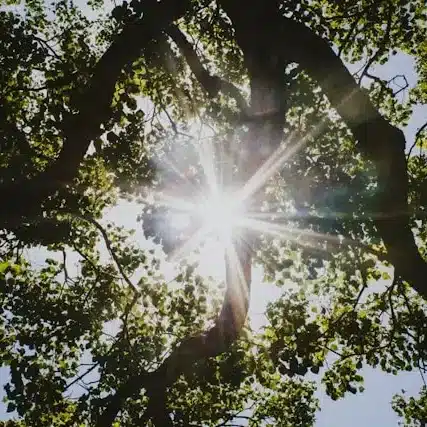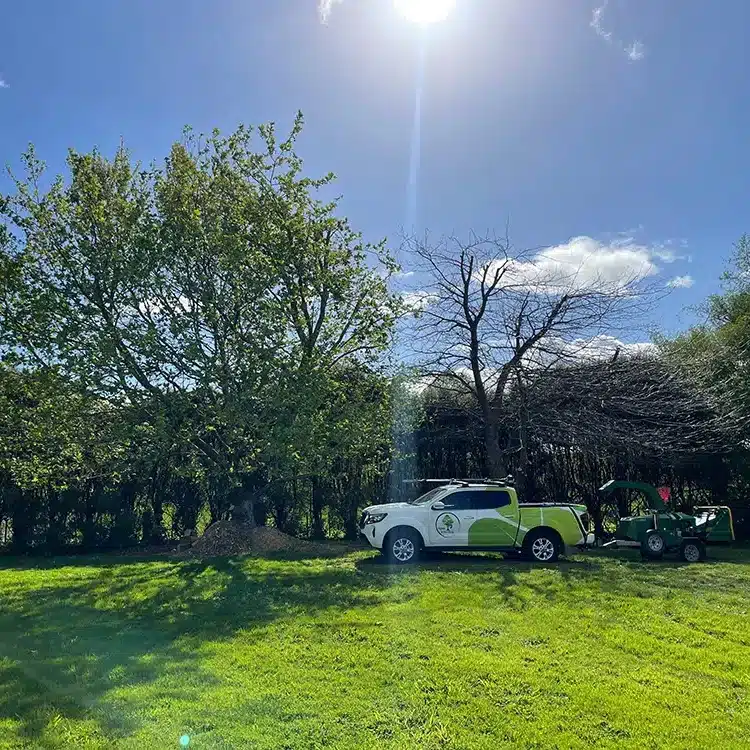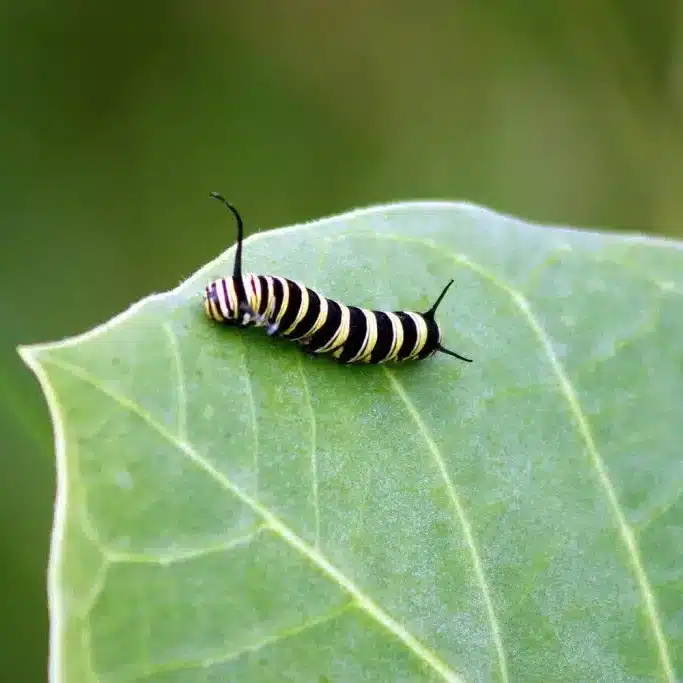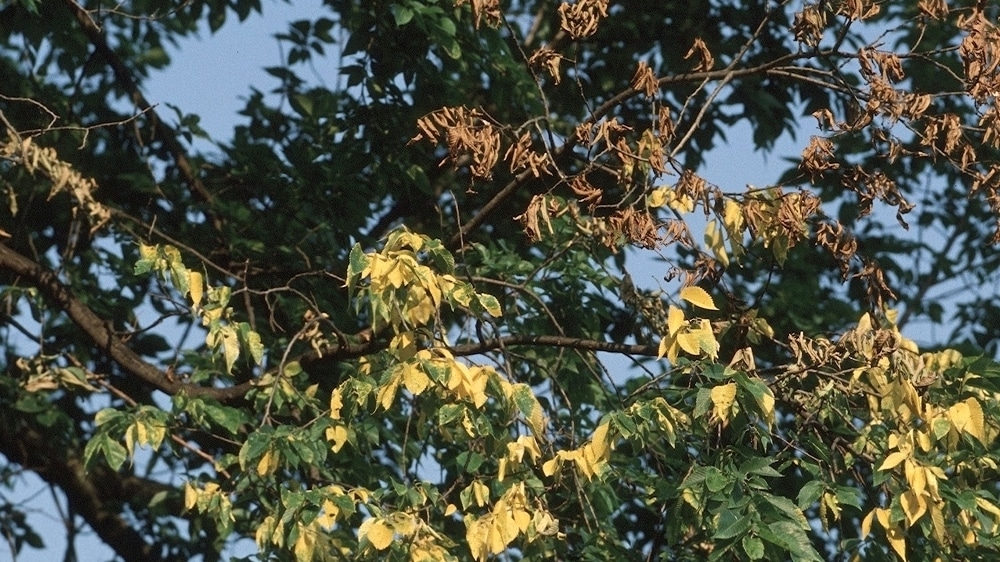
Credit: Joseph OBrien, USDA Forest Service, Bugwood.org
Dutch Elm Disease (DED) is one of the most serious tree diseases in the world, and unfortunately, it has appeared in parts of New Zealand, including the Waikato region. If you are a Hamilton homeowner, it is important to know how to spot the warning signs early and what to do if you suspect your trees might be affected.
At Apex Arborists, we are committed to helping Hamilton’s trees stay strong, healthy, and disease-free. In this article, we explain what Dutch Elm Disease is, how it is affecting our region, and how you can protect your trees from this serious threat.
What is Dutch Elm Disease?
Dutch Elm Disease is caused by a fungal pathogen (Ophiostoma novo-ulmi or Ophiostoma ulmi) which spreads between trees via beetles and through underground root systems. Once the fungus invades, it blocks the tree’s vascular system, which carries water and nutrients, leading to rapid wilting, dieback, and ultimately tree death.
The disease is usually spread by tiny elm bark beetles, which carry fungal spores from infected trees to healthy ones as they burrow into the bark. It is a deadly combination that can destroy even mature, well-established trees within a season or two if left untreated.
Dutch Elm Disease devastated elm populations across Europe and North America during the twentieth century. Although New Zealand has been relatively fortunate, isolated outbreaks are appearing more frequently, particularly in the Waikato.
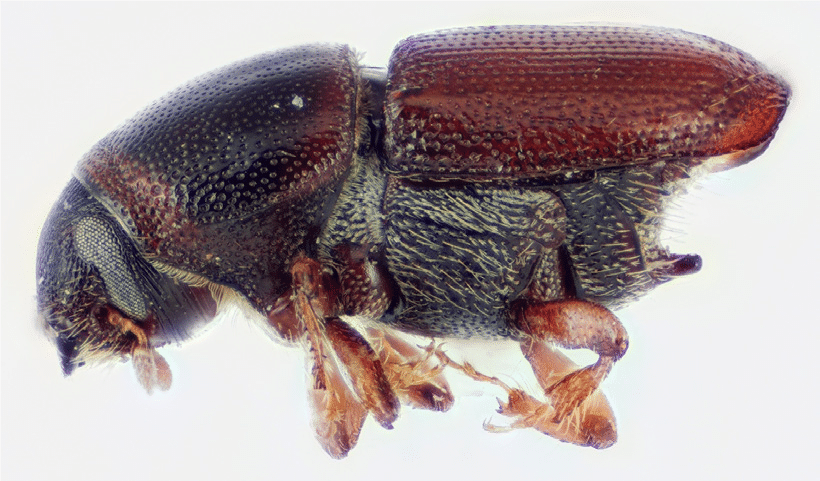
Adult European elm bark beetle. Credit: J. Benzel, Screening Aids,
USDA APHIS ITP, Bugwood.org
Is Dutch Elm Disease in Hamilton?
Yes, Dutch Elm Disease has been confirmed in several parts of the greater Waikato region. According to the Waikato Regional Council, DED was first identified in New Zealand in 1989 in central Auckland. Since then, it has spread into the north Waikato and continues to pose a serious threat to elm trees across the region, including Hamilton.
The Council considers Dutch Elm Disease one of the most devastating tree diseases globally. It highlights the fungus’s ability to block the water and nutrient pathways in trees, which leads to rapid decline and death. The good news is that early detection and correct action can reduce the risk of spread, but it does require homeowner awareness and swift professional intervention.
The Waikato Regional Council also provides detailed information on the beetle vectors, affected tree species, and appropriate management techniques. We recommend reading their DED management guide if you want to learn more about how the disease spreads and the regional efforts to contain it.
Early Signs of Dutch Elm Disease
The earlier you detect Dutch Elm Disease, the better your chances of saving your tree or preventing the infection from spreading to other trees on your property and in your neighbourhood.
Signs to watch for include:
- Sudden yellowing or browning of leaves, especially during spring and summer
- Leaves wilting or curling even though soil moisture levels are normal
- Branches dying back from the tips inward, creating a sparse canopy
- Brown or black streaks in the sapwood under the bark
- Heavy leaf drop during the growing season, long before autumn
- Clusters of dead branches at the top of the tree
In Hamilton’s mild winters and humid springs, fungal diseases like DED can develop rapidly. Even a few warm days are enough to activate bark beetles, increasing the risk of spread.
What to Do If You Suspect Infection
If you spot any of the symptoms mentioned above, taking immediate action is crucial:
- Avoid cutting, pruning, or moving infected wood yourself.
Handling infected branches without proper care can spread the disease. - Do not chip or compost infected material.
Infected wood must be properly disposed of to prevent further contamination. - Contact a professional arborist straight away.
Diagnosing tree diseases requires professional training. At Apex Arborists, we can assess the health of your tree, confirm the presence of Dutch Elm Disease or other issues, and recommend the best course of action.
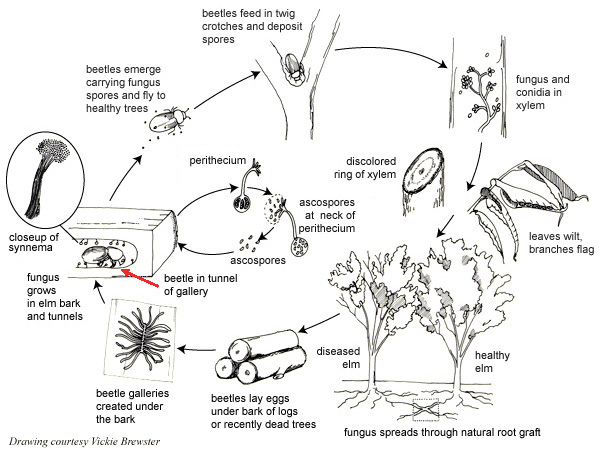
Drawing showing cycle of disease. Drawing: Vickie Brewster
How Apex Arborists Can Help
Apex Arborists offers a full range of professional tree health services, focused on early detection, responsible treatment, and expert care. Our services include:
- Professional diagnosis of tree diseases common in the Waikato region
- Safe removal of infected or hazardous trees, following council regulations and best practices
- Preventative care programmes, including pruning, pest management, and soil improvement
- Tailored tree maintenance plans to promote long-term health and resilience
Our qualified arborists are based right here in Hamilton and understand the unique challenges of our climate and conditions.
Book a Tree Health Assessment Today
If you are concerned about the health of your trees, or simply want peace of mind, now is the perfect time to arrange a professional tree health check.
At Apex Arborists, we proudly serve Hamilton, Cambridge, Te Awamutu, Morrinsville, and surrounding areas.
- Locally owned and operated
- Certified and insured arborists
- Honest advice and no-obligation quotes


